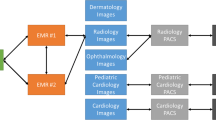Abstract
In Consolidated Enterprises, there are often more than one set of patient identities or some amount of historic records, such as imaging exams that are still identified by more than one patient identity (also known as a Patient Identifier or Medical Record Number) per person. Information technology systems often need some capability to cross-reference records for the same patient so that the records are linked to the one, correct person. If not, it may create a risk for the patient. Historically, each independent facility or organization managed its own patient identity information, including the unique identifier/Medical Record Number. This can result in a fractured view of a patient’s records. To present a longitudinal, unified-view record of a patient, it is necessary to have functions to manage these multiple domains. Without this capability, multiple patient identity domains result in a broken imaging record for the patient and often prevents the discovery of, access to, and comparison of a patient’s imaging exams. Even worse, without a method to manage patient identity across records where more than one patient identity domain is involved, the records for two different people can be linked to one patient, resulting in a potentially serious risk for harm. This paper proposes a maturity model to assess and categorize the capabilities of different imaging information technology systems, such as Picture Archiving Communication and Archiving System, Vendor Neutral Archive, and other image management and viewing applications.


Similar content being viewed by others
Notes
Or even within different applications within a single department.
The same model could be applied to other imaging and information application types, such image sharing, Radiology Information System (RIS), and Electronic Medical Record (EMR), but this paper is focused on imaging IT systems.
Or a hierarchical Object Identifier (OID).
Some systems will allow this, with appropriate warnings to the end user.
HL7 International defines the PID—Patient Identification segment. In this section, several fields, such as PID-2, PID-3, and PID-4, are used for patient identifiers.
Sometimes simply called a Master Patient Index (MPI) or, mistakenly, Master Patient Identity.
HL7 International describes different patient merge and split scenarios that an implementation should consider.
Sometimes referred to as the “surviving record.”
See later in this paper for standards-defined methods to preserve the original values.
IRWF.b replaces the original (deprecated) IRWF.
References
HL7 International. http://www.hl7.org/Oid/information.cfm. Accessed 06 April 2020.
IEEE Standards Association. https://standards.ieee.org/content/dam/ieee-standards/standards/web/documents/tutorials/oid.pdf. Accessed 06 April 2020.
HL7 International. https://www.hl7.org/implement/standards/product_brief.cfm?product_id=141. Accessed 06 April 2020.
HL7 International. http://www.hl7.org/. Accessed 06 April 2020.
HL7 International. http://www.hl7.eu/refactored/segPID.html. Accessed 06 April 2020.
HL7 International. https://www.hl7.org/fhir/. Accessed 06 April 2020.
Wikipedia. https://en.wikipedia.org/wiki/Representational_state_transfer. Accessed 06 April 2020.
HL7 International. http://www.hl7.org/fhir/patient.html. Accessed 06 April 2020.
HL7 International. http://www.hl7.org/fhir/datatypes.html#Identifier. Accessed 06 April 2020.
Just BH, Marc D, Munns M, Sandefer R: Why Patient Matching is a Challenge: Research on Master Patient Index (MPI) Data Discrepancies in Key Identifying Fields. Perspect Health Inf Manag. 13: 1-20, 2016.
U.S. Government Accountability Office. https://www.gao.gov/products/GAO-19-197. Accessed 06 April 2020.
Integrating the Healthcare Enterprise International. https://www.ihe.net/uploadedFiles/Documents/Radiology/IHE_RAD_Suppl_IRWF.b.pdf. Accessed 06 April 2020.
HIMSS. https://www.himss.org/patient-identity-integrity-toolkit. Accessed 06 April 2020.
The Office of the National Coordinator for Health Information Technology. https://www.healthit.gov/playbook/pddq-framework/introduction/. Accessed 06 April 2020.
Integrating the Healthcare Enterprise International. https://wiki.ihe.net/index.php/Main_Page. Accessed 06 April 2020.
Integrating the Healthcare Enterprise International. https://wiki.ihe.net/index.php/Patient_Identifier_Cross-Reference_for_Mobile_(PIXm). Accessed 06 April 2020.
Author information
Authors and Affiliations
Corresponding author
Ethics declarations
Conflict of Interest
The authors declare that they have no conflict of interest.
Additional information
Publisher’s Note
Springer Nature remains neutral with regard to jurisdictional claims in published maps and institutional affiliations.
Rights and permissions
About this article
Cite this article
Dennison, D. Patient Identity Management Maturity Model (PIM3) for Imaging Information Technology Systems. J Digit Imaging 34, 473–482 (2021). https://doi.org/10.1007/s10278-021-00429-2
Received:
Revised:
Accepted:
Published:
Issue Date:
DOI: https://doi.org/10.1007/s10278-021-00429-2




